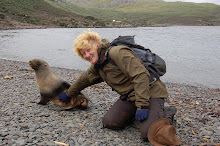It is comprised of three main parts: giving the territory-holding male animals individual paint marks so that they can be tracked throughout the season, as well as taking genetics samples; counting and identifying (through the use of flipper tags and implanted microchips) the females as they arrive to pup; and counting, marking with flipper tags and microchips and taking birth weights and genetic samples from the newborn pups. We also post-mortem any pups that die, to ascertain a cause of death.
The seal team (this season, myself and Jaume) visit the beach every day at 09:00, and twice-daily (09:00 and 17:00) once the first pup is born, and this continues until a week after the last pup is born on the beach - usually the first week of January. It is a short but very intense season - during the peak period (Dec 1 - Dec 15) we can be on the beach for as much as 8 hours per day.
Thus far only a few bull seals have returned. The females will start to arrive by the middle of the month, with pups very soon after. The number of animals on the beach each day builds to a peak around Dec 10th and by 15th the hardest period is over and things start to calm down. By then, many of the mothers are at sea on foraging trips, the males are starting to disappear after six weeks fighting for territories, and the older pups have started to explore further from their birthplaces!
The beach is about 1.5x the size of a tennis court, but incredibly is the birthplace of over 700 pups each year. It is almost impossibly crowded, and the only way we can work there is by means of an aerial gantry constructed of scaffolding, allowing us to work close to but at a safe distance from the seals. There is a small wendy house for storage of the kit, and to allow us the opportunity to get out of the worst of the weather.
Last year was the third-most successful year (in terms of numbers of pups) for a decade, with 736 pups born (769 was the recent record). If this year approaches that number of births, then it will be the third 'good' year in a row. This suggests that the at-sea foraging conditions for the Bird Island predators are very good at this time.
It is a lovely bit of work - hard on the body and mind (physically strenuous work and long hours) but wonderful spending time in such close proximity to the seals. Although the endangered wandering albatrosses steal the show on Bird Island, surely most people's memories, especially of visitors during the height of the summer, will be filled with the antics of the handsome, intelligent and beautiful fur seals.





No comments:
Post a Comment